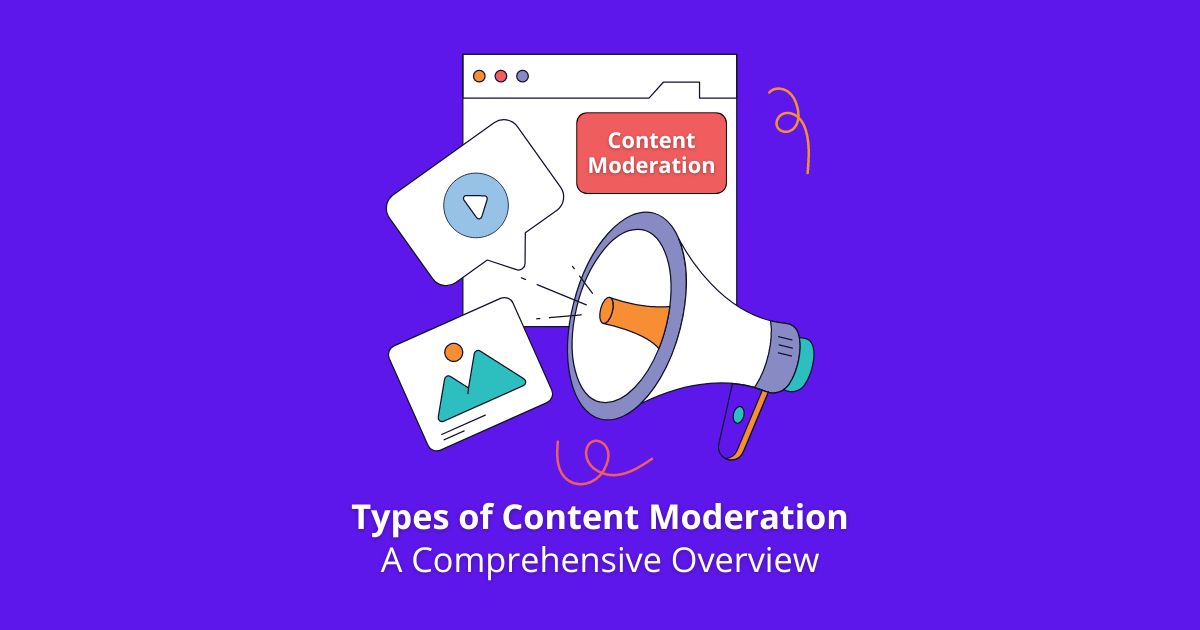In the digital age, content moderation has become a critical component of maintaining healthy online environments. As platforms and social media networks continue to grow, so does the need for robust systems that can manage and monitor the vast amounts of content generated daily. This article explores the various types of content moderation, detailing their mechanisms, advantages, and challenges.

1. Pre-Moderation
Pre-moderation is a proactive approach where content is reviewed before it is published on a platform. This method ensures that any inappropriate, harmful, or non-compliant material is filtered out before it reaches the public eye.
Mechanism: Content submitted by users is queued for review by moderators, who evaluate its adherence to community guidelines and terms of service before approval.
Advantages:
- Prevents the spread of harmful or offensive content.
- Protects the platform’s reputation by ensuring all visible content is appropriate.
Challenges:
- Can cause delays in content publishing, leading to user frustration.
- Requires significant manpower or sophisticated AI to handle high volumes of submissions.
2. Post-Moderation
In contrast to pre-moderation, post-moderation allows content to be published immediately, with a review process occurring afterward. This method is commonly used in large-scale platforms where speed of content delivery is crucial.
Mechanism: Content is made available immediately after submission. Moderators then review the content and remove or flag it if it violates community standards.
Advantages:
- Facilitates real-time content sharing, enhancing user experience.
- Lessens the immediate workload on moderators.
Challenges:
- Harmful content may be visible for some time before being removed.
- Reactive rather than preventive, potentially causing damage before action is taken.
3. Reactive Moderation
Reactive moderation relies on user reports to flag inappropriate content. Users play an active role in maintaining the platform’s standards by reporting violations.
Mechanism: Users report content they find inappropriate. Moderators then review these reports and decide on the necessary action.
Advantages:
- Empowers users to take part in maintaining community standards.
- Efficient for platforms with large user bases where pre- or post-moderation would be impractical.
Challenges:
- Inappropriate content may remain visible until reported and reviewed.
- Users might abuse the reporting system, leading to false positives or targeted harassment.
4. Distributed Moderation
Distributed moderation, often used in decentralized and community-driven platforms, involves the entire community in the moderation process.
Mechanism: Online content moderation responsibilities are shared among community members who vote or comment on the appropriateness of content.
Advantages:
- Engages the community in upholding standards, fostering a sense of ownership and responsibility.
- Reduces the workload on a central moderation team.
Challenges:
- Risk of biased moderation due to dominant community opinions.
- Difficulty in maintaining consistent moderation standards.
5. Automated Moderation
Automated moderation uses artificial intelligence (AI) and machine learning (ML) algorithms to monitor and manage content. This method is becoming increasingly popular due to advancements in technology.
Mechanism: Algorithms analyze content in real-time, flagging or removing items that violate predetermined rules based on keyword detection, image recognition, and contextual analysis.
Advantages:
- Handles large volumes of content efficiently and quickly.
- Reduces the need for human moderators, cutting down operational costs.
Challenges:
- AI might struggle with context, leading to false positives or negatives.
- Requires constant updating to stay effective against new types of violations.
6. Hybrid Moderation
Hybrid moderation combines automated systems with human oversight to leverage the strengths of both methods. This approach is commonly used to balance efficiency and accuracy.
Mechanism: Automated tools initially filter content, with flagged items being sent to human moderators for further review.
Advantages:
- Increases efficiency while maintaining a human touch for nuanced decisions.
- Reduces the volume of content human moderators need to review directly.
Challenges:
- Requires significant resources to implement and maintain both systems.
- Potential for delays if the volume of flagged content is high.
7. Community-Based Moderation
Community-based moderation involves a small group of trusted community members who are given moderation privileges. These moderators are often volunteers familiar with the community’s standards and culture.
Mechanism: Selected community members review and manage content, ensuring adherence to platform rules.
Advantages:
- Moderators are typically more in tune with the community’s needs and standards.
- Reduces the workload on platform administrators.
Challenges:
- Volunteer moderators might lack the training and support needed for effective moderation.
- Potential for bias or favoritism.
8. Proactive Moderation
Proactive moderation focuses on anticipating and preventing violations before they occur by analyzing trends and implementing preventative measures.
Mechanism: Platforms use data analytics and user behavior patterns to predict potential issues and take preventive action, such as warning users or adjusting algorithmic content delivery.
Advantages:
- Prevents issues before they escalate, maintaining a healthier environment.
- Enhances user experience by minimizing exposure to harmful content.
Challenges:
- Requires advanced data analytics and predictive capabilities.
- May not be able to anticipate all types of violations.
Conclusion
Content moderation is a multifaceted challenge that requires a combination of approaches to be effective. Each type of moderation has its unique strengths and limitations, and the choice of method often depends on the platform’s size, nature, and community needs.
As technology evolves, so too will the strategies for content moderation, aiming to create safer and more welcoming online spaces for all users. Balancing the need for open communication with the necessity of protecting users from harmful content remains the ultimate goal of content moderation.